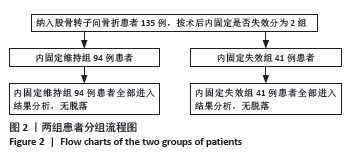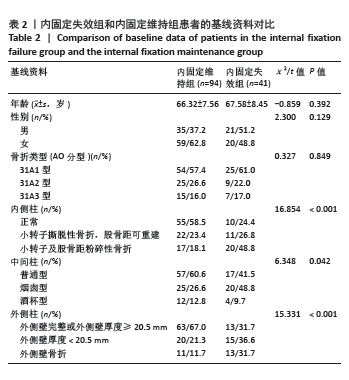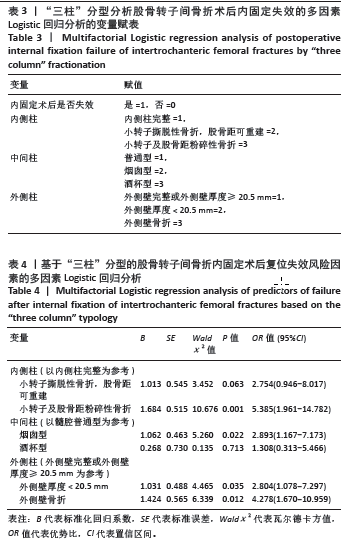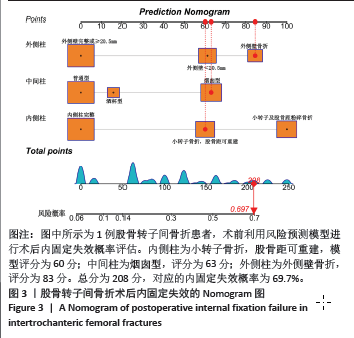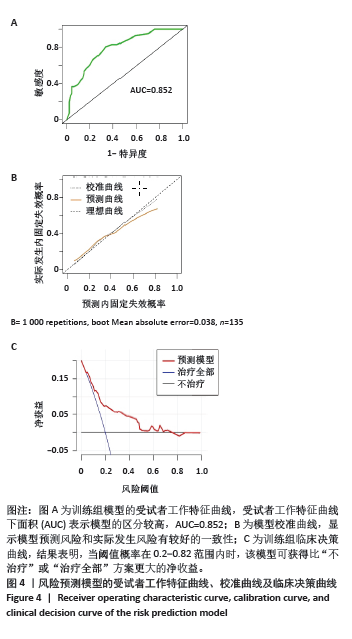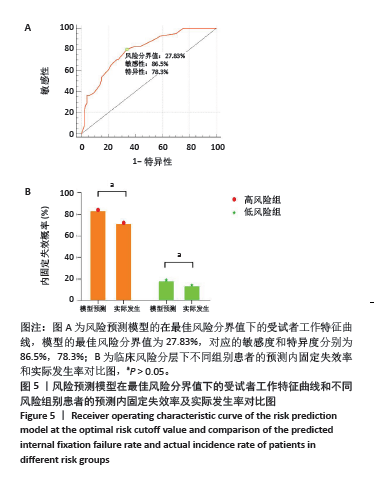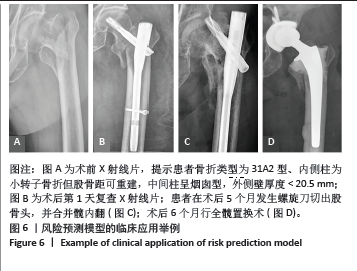[1] CAI C, TIAN L, CHEN Z, et al. Cementless bipolar hemiarthroplasty compared with proximal femoral nail anti-rotation of unstable intertrochanteric fractures in senile patients with osteoporosis: a retrospective study. BMC Musculoskelet Disord. 2022;23(1):461.
[2] LIANG Y, LIU S, LI L, et al. Proximal femoral nail antirotation versus external fixation for unstable intertrochanteric fractures in elderly patients: A randomized controlled trial. Medicine (Baltimore). 2022;101(28):e29384.
[3] 武英楷,王瑞强,宁尚攀,等.股骨近端防旋髓内钉固定股骨转子间骨折失败的因素[J]. 中国矫形外科杂志,2022,30(22):2050-2054.
[4] RICCI WM. Stability of Intertrochanteric Femur Fractures. J Orthop Trauma. 2023;37(10S):S1-S4.
[5] LEE Y, KIM J, PARK CH, et al. Analysis of risk factor for nail breakage in patients with mechanical failures after proximal femoral nail antirotation in intertrochanteric fractures. Medicine. 2022;101(25):e29436.
[6] YOON Y, KIM J, CHO J, et al. Simple guidelines for evaluating intraoperative alignment after the reduction of intertrochanteric fractures. Asian J Surg. 2021;44(1):66-71.
[7] KALIA RB, ARORA SS, SARKAR B, et al. A comprehensive 3D CT based classification of intertrochanteric fracture. J Clin Orthop Trauma. 2022;30:101912.
[8] WADA K, MIKAMI H, AMARI R, et al. A novel three-dimensional classification system for intertrochanteric fractures based on computed tomography findings. J Med Invest. 2019;66(3.4):362-366.
[9] 张殿英. 支撑-牵张效应对股骨转子间骨折内固定稳定的影响[J].中华骨科杂志,2022,42(2):77-83.
[10] 洪加源, 缪建云, 康两期, 等. PFNA辅助微创锁定钢板治疗合并有外侧壁骨折的高龄老年股骨转子间骨折28例[J].中国中医骨伤科杂志,2019,27(1):45-46.
[11] MIJDERWIJK HJ, BEEZ T, HANGGI D, et al. Clinical prediction models. Childs Nerv Syst. 2020;36(5):895-897.
[12] DE JONG V, ROUSSET RZ, ANTONIO-VILLA NE, et al. Clinical prediction models for mortality in patients with covid-19: external validation and individual participant data meta-analysis. BMJ. 2022;378:e69881.
[13] 中国脆性骨折联盟, 中国老年医学学会骨与关节分会创伤骨科学术工作委员会, 白求恩·骨科加速康复联盟, 等. 老年股骨转子间骨折诊疗指南[J].中华创伤骨科杂志,2020,22(2):93-99.
[14] 夏纪伍, 康斌, 王德利, 等. 股骨距骨密度变化对老年髋部骨折类型的影响研究[J]. 中华骨与关节外科杂志,2020,13(4):295-298.
[15] 杜心如, 卢世璧. 骨质疏松时股骨上段髓腔形态学特点及其临床意义[J]. 中国临床解剖学杂志,2006,24(6):631-633.
[16] 冯俊超, 高明暄, 骆文远. 股骨转子间骨折外侧壁与内侧壁的意义[J]. 中国矫形外科杂志,2023,31(5):436-440.
[17] DORR LD, FAUGERE MC, MACKEL AM, et al. Structural and cellular assessment of bone quality of proximal femur. Bone. 1993;14(3):231-242.
[18] LI S, SU ZH, ZHU JM, et al. The importance of the thickness of femoral lateral wall for treating intertrochanteric fractures: a finite elements analysis. Sci Rep. 2023;13(1):12679.
[19] 高永祥, 张晋昕. Logistic回归分析的样本量确定[J].循证医学, 2018,18(2):122-124.
[20] VAN SMEDEN M, MOONS KG, DE GROOT JA, et al. Sample size for binary logistic prediction models: Beyond events per variable criteria. Stat Methods Med Res. 2019;28(8):2455-2474.
[21] GLANS M, KEMPEN T, JAKOBSSON U, et al. Identifying older adults at increased risk of medication-related readmission to hospital within 30 days of discharge: development and validation of a risk assessment tool. BMJ Open. 2023;13(8):e70559.
[22] SHIN WC, JANG JH, JUNG SJ, et al. Advantages and limitations of intramedullary nailing for the surgical treatment of ipsilateral intertrochanteric and femoral shaft fractures: a retrospective comparative study based on propensity score matching. Eur J Trauma Emerg Surg. 2022;48(3):1779-1786.
[23] De VINCENTIS A, BEHR AU, BELLELLI G, et al. Orthogeriatric co-management for the care of older subjects with hip fracture: recommendations from an Italian intersociety consensus. Aging Clin Exp Res. 2021;33(9):2405-2443.
[24] MUKHERJEE K, BROOKS SE, BARRACO RD, et al. Elderly adults with isolated hip fractures- orthogeriatric care versus standard care: A practice management guideline from the Eastern Association for the Surgery of Trauma. J Trauma Acute Care Surg. 2020;88(2):266-278.
[25] 聂少波, 张伟, 张里程, 等. 股骨转子间骨折术后内固定失效的危险因素研究进展[J]. 中华创伤骨科杂志,2021,23(3):233-238.
[26] JIANG QL, LI Y, BAI XW, et al. A novel computed tomography-based three-column MLP classification of intertrochanteric fracture. J Med Invest. 2023;70(3.4):524-529.
[27] DO JH, KIM YS, LEE SJ, et al. Influence of fragment volume on stability of 3-part intertrochanteric fracture of the femur: a biomechanical study. Eur J Orthop Surg Traumatol. 2013;23(4):371-377.
[28] KULKARNI SG, BABHULKAR SS, KULKARNI SM, et al. Augmentation of intramedullary nailing in unstable intertrochanteric fractures using cerclage wire and lag screws: a comparative study. Injury. 2017;48 Suppl 2:S18-S22.
[29] 李璐兵, 阿依丁·夏哈太, 李飞, 等. 老年髋关节术后发生假体周围骨折的危险因素研究[J].创伤外科杂志,2021,23(10):740-743.
[30] 吴斗, 任鹏宇, 梁伟, 等. 老年股骨近端髓腔形态差异及其对股骨近端防旋髓内钉内固定疗效的影响[J].中华创伤杂志,2018,34(6): 513-520.
[31] WANG F, ZOU JL, SHANG J. Does matching degree matter for proximal femoral intramedullary nail on reoperation rate in intertrochanteric fractures? J Orthop Surg Res. 2022;17(1):573.
[32] ZHENG L, WONG DW, CHEN X, et al. Risk of proximal femoral nail antirotation (PFNA) implant failure upon different lateral femoral wall thickness in intertrochanteric fracture: a finite element analysis. Comput Methods Biomech Biomed Engin. 2022;25(5):512-520.
[33] 周钰卓, 齐宇新, 马腾洋, 等. 老年股骨转子间骨折PFNA失败的危险因素分析[J]. 中国矫形外科杂志,2020,28(4):292-296.
[34] ABRAM SG, POLLARD TC, ANDRADE AJ. Inadequate ‘three-point’ proximal fixation predicts failure of the Gamma nail. Bone Joint J. 2013;95-B(6):825-830.
[35] 赵豪, 高山, 陈庭瑞. 外侧壁破裂股骨转子间骨折三种内固定有限元分析[J]. 中国矫形外科杂志,2023,31(6):538-542.
[36] WANG R, ZHANG H, WEI Q, et al. Intramedullary nails in combination with reconstruction plate in the treatment of unstable intertrochanteric femoral fractures with lateral wall damage. Int Orthop. 2021;45(11):2955-2962.
[37] ZHOU X, YANG J, FANG S. Comment on Shi et al.: Association of the lateral wall integrity with clinical outcomes in older patients with intertrochanteric hip fractures treated with the proximal femoral nail anti-rotation-Asia. Int Orthop. 2022;46(4):925-926.
[38] CHEN WH, GUO WX, GAO SH, et al. Arthroplasty vs proximal femoral nails for unstable intertrochanteric femoral fractures in elderly patients: A systematic review and meta-analysis. World J Clin Cases. 2021;9(32):9878-9888.
[39] JAWAD MJ. Evaluation of using PFN (proximal femoral nailing) in treatment of unstable intertrochanteric fractures in elderly patients. J Pak Med Assoc. 2021;71(Suppl 8)(12):S179-S184.
[40] 陈漳鑫, 胡翠玉, 郑振华, 等. MIPPO重建外侧壁联合PFNA固定与单纯Intertan髓内钉固定治疗外侧壁不完整的股骨转子间骨折疗效比较[J]. 中国修复重建外科杂志,2020,34(9):1085-1090. |
